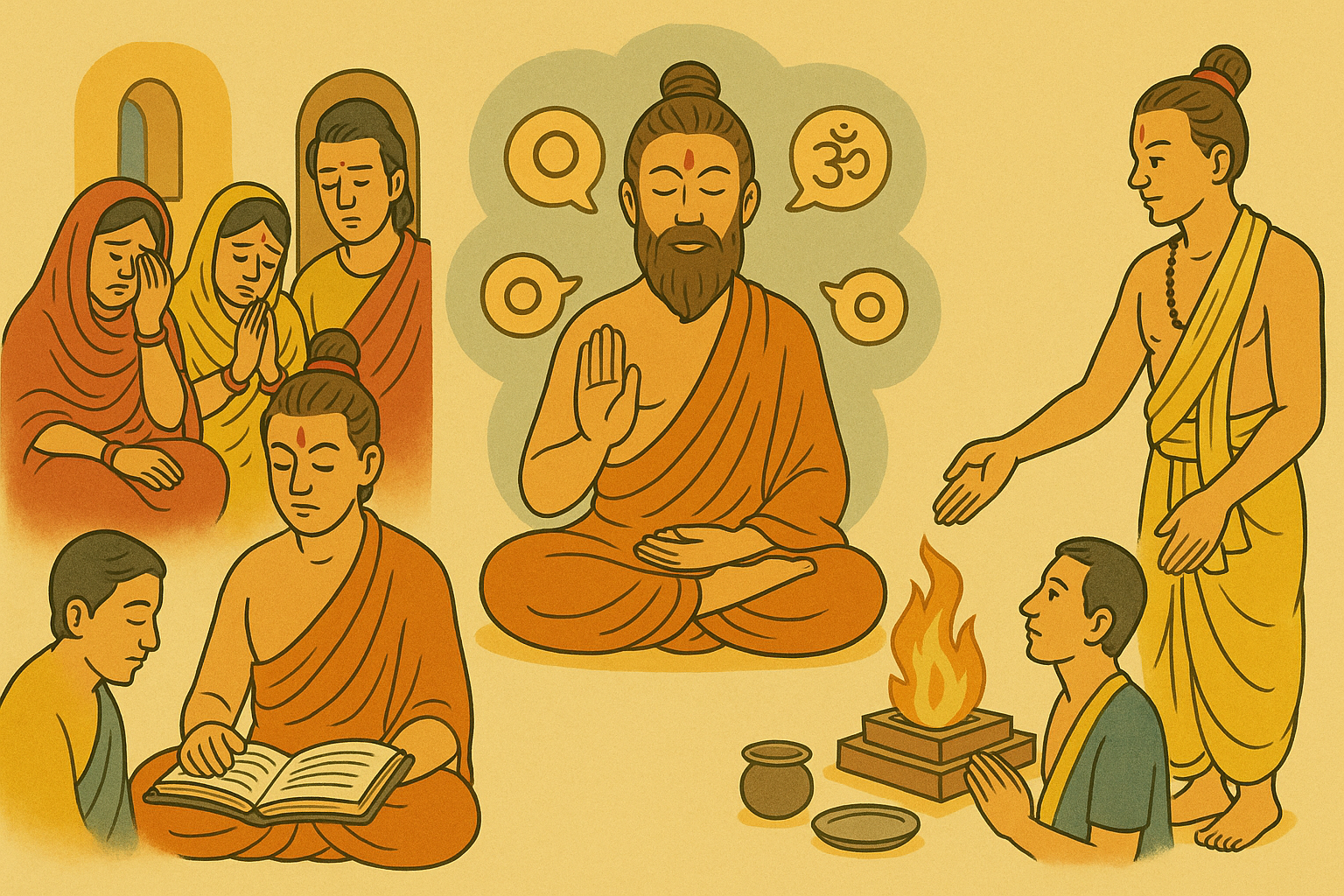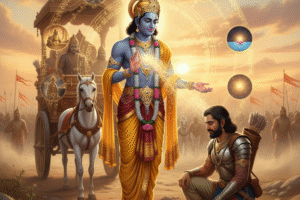
Mourning Rituals,Sabda-Brahma & Devata,Brahmana Dharma
- Posted by Sri Kameswari Foundation
- Date July 29, 2025
- Comments 0 comment
To truly grasp the depth of Sāṅkhya Yoga and the reasons behind Arjuna’s persistent delusion,it is essential to understand the following foundational concepts: Mourning Rituals,Śabda-Brahma & Devatā and Brāhmaṇa Dharma.
Mourning Rituals
There is a tradition of observing a ten-day mourning period when we lose a family member.During this time,we are advised to withdraw from worldly activities and spend time with our close family members,reflecting on the event and engaging with texts like the Garuda Purana to understand concepts such as karma siddhānta.
This is because such a loss is not minor,and coping with the grief alone can be overwhelming.Since the pain is largely psychological rather than physical,being with family helps us navigate the emotional turmoil and provides the necessary support.
Unfortunately,we are increasingly neglecting these time-tested rituals,often citing professional or social commitments as excuses.In doing so,we deprive ourselves of the space and time needed to process grief.This unaddressed sorrow then lingers,impacting us on deeper psychological levels.
The timelines defined by our Ṛṣis—whether jātaśaucam,mṛtaśaucam,or rajasvaladoṣa—carry profound significance.They aid in both physical and psychological cleansing.If we can revive these customs in our daily lives,we not only uphold our traditions but also lead a life of greater inner purity that supports spiritual growth.
Śabda-Brahma & Devatā
In Sanātana Dharma,the term “Devata” is used in different contexts,each carrying its own depth and significance.
The idols we worship in temples or homes are called Devatas.However,in our culture,everything that emerges from Mother Nature—be it a stone,tree,mountain or rever—is also revered as a Devata.This reflects the deep-rooted vision of divinity in all forms of existence.
We are also taught that mantras themselves are Devatas.In fact,the Vedas are considered Devata-svarūpas—where Devatas are manifested in the form of śabda (sound).The sounds we hear during Vedic chanting are just the outer expressions.When we approach these sounds with tapas (austerity),intensity, dedication and continuity,they lead us beyond the physical sound, allowing us to have the darśana (vision) of the Devata that resides in them.
In Bhartṛhari’s Vākyapadīya,it is said that sound (śabda) exists in various forms and that creation itself has emerged from sound.The term Śabda-Brahma encapsulates this: “Brahma” refers to the source of all creation,and “Śabda” qualifies it—indicating that sound is the very basis of this creation.
Scriptures like the Mahābhārata,Śrīmad Bhagavad Gītā and Rāmāyaṇa are not mere narratives; they are equivalent to the Vedas and are also considered expressions of Śabda-Brahma,the very embodiment of Devata.The Mahābhārata is even referred to as the Pañcama Veda (the fifth Veda), with several chapters deeply focused on jñāna (spiritual wisdom).
We should not read these scriptures as mere stories.When read with awareness and the intent to discover the hidden jñāna,they become transformative and uplifting on our spiritual journey.
After knowing all this,one may wonder:
“I am also producing sounds when I speak—can that be considered Brahman too?”
The answer lies in understanding the four levels of vāk (speech):Para,Paśyantī,Madhyamā, and Vaikharī.
What we usually express through our mouths is Vaikharī,the grossest form of speech—especially when spoken from an egoistic,individualistic standpoint (“I am speaking”). Only that speech which arises from the Para level—the subtlest form,rooted in pure consciousness and oneness—can truly be called Śabda-Brahma.
This is the kind of speech we experience when we listen to divine personalities—their words carry transformative power because they emerge from the deepest layers of being.
Brāhmaṇa Dharma – The Six Duties of a Brāhmaṇa
Adhyayanam (Study):
A Brāhmaṇa should be committed to jñāna-samuparjana—the continuous pursuit of knowledge. He must study the Vedas and śāstras diligently.
Adhyāpanam (Teaching):
He must also share that knowledge with others for the upliftment and welfare of society.
Yajanam (Performing Sacrifices):
He should perform yajñas and yāgas as offerings (dravya-tyāga) to the Devatās with sincerity and devotion.
Yājanam (Conducting Rituals for Others):
He should be qualified to conduct sacrificial rites on behalf of others,serving as a priest when required.
Dānam (Giving Donations):
During important saṁskāras like Upanayanam,Vivāha etc., he should give dāna (donations) with generosity.
Pratigrahaṇam (Receiving Donations):
He is also permitted to accept gifts and donations from others. Even when he asks for support of his livelihood,it is considered dharma,not inappropriate.
This post covers the concepts related to the 5th episode. Please click on the “Ch-2|Meaning of Shlokas 4&5” link in the Śrīmadbhagavadgītā Tattvamu home page to read the meaning,that has been explained in Episode-5.
You can also listen to this in Telugu from our Āchārya,Dr. Jammalamadaka Suryanārāyaṇa garu,by clicking the video below.
You may also like

Pratyabhijna,The Deeper Meaning of Antaha,Atma Tattvam

Ch-2|Meaning of Shlokas 15-17

